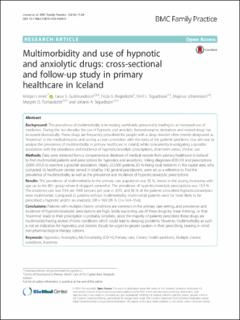| dc.contributor.author | Linnet, Kristjan | |
| dc.contributor.author | Gudmundsson, Larus J. | |
| dc.contributor.author | Birgisdottir, Frida G | |
| dc.contributor.author | Sigurdsson, Emil Larus | |
| dc.contributor.author | Jóhannsson, Magnús, Lyfjastofnun | |
| dc.contributor.author | Tomasdottir, Margret Olafia | |
| dc.contributor.author | Sigurdsson, Johann Agust | |
| dc.date.accessioned | 2020-04-29T12:40:15Z | |
| dc.date.available | 2020-04-29T12:40:15Z | |
| dc.date.created | 2017-01-03T11:48:18Z | |
| dc.date.issued | 2016 | |
| dc.identifier.citation | BMC Family Practice. 2016, 17 (69), . | en_US |
| dc.identifier.issn | 1471-2296 | |
| dc.identifier.uri | https://hdl.handle.net/11250/2652947 | |
| dc.description.abstract | Background
The prevalence of multimorbidity is increasing worldwide, presumably leading to an increased use of medicines. During the last decades the use of hypnotic and anxiolytic benzodiazepine derivatives and related drugs has increased dramatically. These drugs are frequently prescribed for people with a sleep disorder often merely designated as “insomnia” in the medical records and lacking a clear connection with the roots of the patients’ problems. Our aim was to analyse the prevalence of multimorbidity in primary healthcare in Iceland, while concurrently investigating a possible association with the prevalence and incidence of hypnotic/anxiolytic prescriptions, short-term versus chronic use.
Methods
Data were retrieved from a comprehensive database of medical records from primary healthcare in Iceland to find multimorbid patients and prescriptions for hypnotics and anxiolytics, linking diagnoses (ICD-10) and prescriptions (2009–2012) to examine a possible association. Nearly 222,000 patients, 83 % being local residents in the capital area, who contacted 16 healthcare centres served in total by 140 general practitioners, were set as a reference to find the prevalence of multimorbidity as well as the prevalence and incidence of hypnotic/anxiolytic prescriptions.
Results
The prevalence of multimorbidity in the primary care population was 35 %, lowest in the young, increasing with age up to the 80+ group where it dropped somewhat. The prevalence of hypnotic/anxiolytic prescriptions was 13.9 %. The incidence rate was 19.4 per 1000 persons per year in 2011, and 85 % of the patients prescribed hypnotics/anxiolytics were multimorbid. Compared to patients without multimorbidity, multimorbid patients were far more likely to be prescribed a hypnotic and/or an anxiolytic, OR = 14.9 (95 % CI = 14.4–15.4).
Conclusions
Patients with multiple chronic conditions are common in the primary care setting, and prevalence and incidence of hypnotic/anxiolytic prescriptions are high. Solely explaining use of these drugs by linear thinking, i.e. that “insomnia” leads to their prescription is probably simplistic, since the majority of patients prescribed these drugs are multimorbid having several chronic conditions which could lead to sleeping problems. However, multimorbidity as such is not an indication for hypnotics, and doctors should be urged to greater caution in their prescribing, bearing in mind non-pharmacological therapy options. | en_US |
| dc.language.iso | eng | en_US |
| dc.publisher | BioMed Central | en_US |
| dc.rights | Navngivelse 4.0 Internasjonal | * |
| dc.rights.uri | http://creativecommons.org/licenses/by/4.0/deed.no | * |
| dc.title | Multimorbidity and use of hypnotic and anxiolytic drugs: Cross-sectional and follow-up study in primary healthcare in Iceland | en_US |
| dc.type | Peer reviewed | en_US |
| dc.type | Journal article | en_US |
| dc.description.version | publishedVersion | en_US |
| dc.source.pagenumber | 10 | en_US |
| dc.source.volume | 17 | en_US |
| dc.source.journal | BMC Family Practice | en_US |
| dc.source.issue | 69 | en_US |
| dc.identifier.doi | 10.1186/s12875-016-0469-0 | |
| dc.identifier.cristin | 1419818 | |
| dc.description.localcode | Open Access This article is distributed under the terms of the Creative Commons Attribution 4.0 International License (http://creativecommons.org/licenses/by/4.0/), which permits unrestricted use, distribution, and reproduction in any medium, provided you give appropriate credit to the original author(s) and the source, provide a link to the Creative Commons license, and indicate if changes were made. The Creative Commons Public Domain Dedication waiver (http://creativecommons.org/publicdomain/zero/1.0/) applies to the data made available in this article, unless otherwise stated. | en_US |
| cristin.ispublished | true | |
| cristin.fulltext | original | |
| cristin.qualitycode | 1 | |

